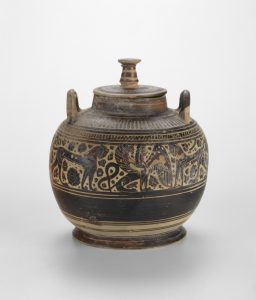18 Chapter 5.1: Greek Art: Overview, the Geometric and Orientalizing Periods, and Greek Vases
MODULE 5: GREEK ART, PART I: Overview, the Geometric and Orientalizing Periods, and Greek Vases
Ancient Greece is widely regarded as laying the foundation for Western civilization in the realm of politics, language, philosophy, theatre, art, and architecture. This module traces the evolution of Greek art and architecture through various sub-periods (Geometric, Orientalizing, Archaic, Classical, and Hellenistic). Each period in Greek art is marked by specific historical events and cultural and artistic developments. The discussions of individual artworks examine popular subjects in Greek art and how their meaning reflected their location or context. How works of art conformed to the stylistic characteristics of the various sub-periods will also be explored.
INTRODUCTION TO ANCIENT GREECE
This short video provides a brief introduction to many aspects of brief civilization including its location, system of government, military and more.
Ancient Greece 101 by National Geographic
Ancient Greece Intro TASK
After watching the video, please respond the following prompts based on the information from the video.
Ancient Greece 101 | National Geographic
Location:
Extent of Empire:
City-states:
Military:
Religion:
INTRODUCTION TO GREEK ART AND ARCHITECTURE
Scholars divide the study of Greek art into sub-periods. For each of these the art displayed similar stylistic characteristics and imagery. Some of the dates of the sub-periods is marked by important historical events or changes in society that generated new forms or styles of art.
Greek Art Intro TASK
After reviewing the three sources below (not all cover the different periods equally), please respond to the instructions given.
- How did Ancient Greek art start?
- Introduction to Ancient Greek Art, by Dr. Renee M. Gondek, Smarthistory.org (follow link)
 https://smarthistory.org/greek_intro/
https://smarthistory.org/greek_intro/ - Greek Art history, by Phil Hansen
Greek art intro TASK instructions:
Below is a list of the subperiods of Greek art (the Dark Ages is not included). For each one, provide the dates for it as well as any relevant historical events, societal changes, or artistic achievements.
Geometric:
Orientalizing:
Archaic:
Classical:
Hellenistic:
PERIODS IN GREEK ART
GEOMETRIC PERIOD
During the earliest phase in the development of Greek art, the Geometric period, Greek society was beginning to emerge from the period after the fall of the Mycenaean empire, often referred to as the Dark Ages.
Arstor Gallery for UNO Students
Below is a link to collection of images in Artstor of Greek Geometric art. This link is accessible only to current UNO students. If you are off-campus, you will be prompted to log in. For a refresher on how to use Artstor, see the UNO Libraries Artstor Libguide.
Artstor gallery of Greek Geometric Art for UNO Students
Geometric TASK
The video in this section describes specific evolutions in society that led Greece to emerge as a unique and unified civilization. After watching the video, please respond to the accompanying questions/prompts.
Greek History – The Geometric Period (1000-700 BC) – The Benaki Museum
Geometric TASK prompts:
Dates of Greek Geometric:
Where and when did the Geometric style emerge?
What new developments took place?
What are the characteristics of the Geometric style?
GEOMETRIC VASES
Although Greeks created jewelry and sculpture during the Geometric period, one of the most characteristic art forms from the time was pottery. Ceramic vessels came in numerous shapes and sizes, which conformed to their function. During the Geometric period a unique form of decoration adorned the surfaces of the vases.
Geometric Vase TASK
After watching the video below on a famous Greek vase from the Dipylon cemetery, please answer the accompanying questions.
Terracotta Krater, Ancient Grece, Dr. Steven Zucker and Dr. Beth Harris
Geometric TASK vase prompts:
What was the function of this vase?
What kinds of shapes ornament the vase?
What is the name of the bands with figures and what is being shown?
Describe the artistic style of the figures?
What did this vase communicate to onlookers?
ORIENTALIZING STYLE
The so-called Orientalizing Style of Greek art is marked by renewed contact between the Greeks and ancient Near Eastern and Mediterranean civilizations. When Greeks traveled to these lands they encountered monumental buildings, sculptures, and unique motifs that left a lasting impression upon them. Specific regions in Greece began to assimilate some of what they saw into their artworks.

Arstor Gallery for UNO Students
Below is a link to collection of images in Artstor of Greek Orientalizing art. This link is accessible only to current UNO students. If you are off-campus, you will be prompted to log in. For a refresher on how to use Artstor, see the UNO Libraries Artstor Libguide.
Artsor Gallery for UNO Students
Orientalizing TASK
The video below explores a Corinthian pyxis, which features motifs that belong to the Orientalizing style. After watching the video, please answer the accompanying questions.
A Corinthian Pyxis, by Lucas Livingston

Orientalizing TASK prompts:
Type and function of vessel:
Dates of the Orientalizing period:
City that embraced Orientalizing:
Hallmarks of Orientalizing style:
Name of artist and signature mark:
Motifs on vessel and their origins:
Origin of lion motif:
Relationship of decoration and function:
GREEK VASE PAINTING
Vases were a popular functional art form not only in every sub-period of Greek art. This section introduces some of the common vase shapes and the Black Figure technique, which gave Greek vases their unique appearance and coloring.
Vase Shapes TASK
Greek vases came in all shapes and sizes and their form was intimately related to how they were used. After exploring the sources below, please answer the accompanying questions.
Greek Vase Painting, an Introduction, by Dr. Renee Gondek (link below)
Link: https://smarthistory.org/greek-vase-intro/
Ancient Greek Pottery — Types of Vases (the music is a bit loud, so you may wish to turn this down)
Greek Vase TASK prompts:
Names and function of Greek vase types:
Krater:
Amphora:
Hydria:
Oinochoe:
Kylix:
More Examples of Greek Vases: Open Online Exhibit from the collection of Greek artifacts at the University of Colorado Art Museum
This link leads to a public exhibition of Greek Vases from the University of Colorado Art Museum. All examples are accompanied by descriptions and context: https://www.colorado.edu/classics/greek-vases-exhibits
Black Figure TASK
The red and black coloring of Greek vases is particularly striking. In early Greek pottery black figures adorned a red background giving name to the Black Figure style. A unique firing process rather than a glaze gave the vases their color. After viewing the video on the technique of black-figure vase painting, please respond to the prompts.
Ancient Greek Vase Production and Black-Figure Technique, Art Institute of Chicago
Black Figure Vase TASK prompts:
Please describe:
Use of slip:
Decoration:
Stages of firing (what occurred in each stage):
Survey of Western Art History I © 2021 by Amy Morris, UNO School of the Arts, is licensed under CC BY-NC-ND 4.0 ![]()
![]()
![]()
![]()

